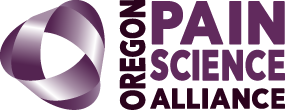The Oregon Pain Science Alliance does not offer personal medical advice; however, the following Pain Science Resources could be useful Next Steps to expand your understanding of Pain Science insights. There are hundreds of resources on the Internet about pain science and mastery approaches that have evolved as more people learn about how the brain constructs pain experiences. Each has a different twist on the emerging understanding of the science of pain and practice, and probably will be helpful for different people. The resources on this list are a few our members have found personally helpful. We have added comments about their uniqueness.
StraightShotHealth.com is Dr. Kevin Cuccaro’s website. It has pain science information for health care workers and for people in pain. He was instrumental in organizing the OPSA, and his free introductory course ‘The Pain Course’ is used for basic knowledge in the membership path of the Alliance.
‘Why We Hurt’, TED Adelaide Australia, https://youtu.be/gwd-wLdIHjs Lorimer Moseley. An enjoyable short video which includes his snake bite story. He is a neuro-scientist who has distilled the recent findings of neuroscience into book form (listed below) for healthcare workers, and is a great story teller.
‘Movement and Pain Science’ (MAPS) is an 8-week program at the Lebanon hospital of the Samaritan Health Services in Oregon. To apply to the program, ask your doctor to refer you for Physical or Occupational therapy at the Lebanon Then call (541)451-7125 to schedule an appointment.
‘Explain Pain Super-Charged’, a 2017 book by Lorimer Moseley and David Butler, distilling the findings of neuroscience in recent decades, with scientific paper citations for most statements in the description, and multiple recommendations for physical therapists. Available from Amazon or https://www.optp.com/G-Lorimer-Moseley
‘Painful Yarns’, a small 2007 book by Lorimer Moseley. This contains 9 personal stories of pain situations he had or observed, along with how the story illustrates an aspect of pain science. Available from Amazon or https://www.optp.com/G-Lorimer-Moseley.
‘The Way Out’, a 2021 book by Alan Gordon LCSW. He defines chronic pain as ‘neuroplastic pain’, which is pain that can be changed. He offers criteria for determining if the pain is neuroplastic, and a Pain Reprocessing Therapy scheme for retraining your brain. Available from http://www.painpsychologycenter.com/the-way-out.html along with a companion workbook download.
‘‘Why Do I Hurt?’‘, a small 2013 book by Adriaan Louw, with insight to how the margin in your nervous system can become sensitized to respond to smaller changes in stimulation, so pain seems to occur with less apparent stimulation. Available from Amazon or OPTO.com.
The Pain Management Guidebook, a very comprehensive, 56 slide pdf, to help people live well with persistent pain, available at https://thehonestphysiocom.files.wordpress.com/2020/07/pain-management-guide-book-v1.02.pdf
While ‘management’ is in the title, the contents are based on pain science.
‘Learn a science-based approach to overcome chronic ’ A website with 27 one-minute slide shows, in 23 languages. The slides show clever graphical explanations about pain. Available at https://www.retrainpain.org/
https://mycuppajo.com/pain-education/ A thoughtful blog by Joletta Bolten about pain education.
https://www/tamethebeast.org This website features useful resources, real stories, and the animated short, ‘Tame the Beast’, narrated by noted pain scientist Lorimer Moseley about rethinking persistent Professor Moseley uses a ‘beast’ in this short to portray the variable persistent pain we have, in the absence of any clear tissue damage.
“A Mindfulness-Based Stress Reduction Workbook” by Bob Stahl, Ph.D. and Elisha Goldstein, Ph.D. This workbook was recommended by Lianne Dyche (an LCSW, associated with Linn County Mental Health Services in Albany, Oregon and Kaiser Permanente Mental Health in Salem, Oregon) and has a wealth of information relative to Mindfulness-Based Stress Reduction. While pain is not the focus of the book, pain science concepts research have shown these practices can help to change one’s relationship with stress, pain, and illnesses. The book is available through Amazon and other on-line book sellers.
We have learned a lot about pain in the last few years. Some of this knowledge is very new and not commonly known. This booklet introduces some important scientific findings about how pain works. While we won’t focus on treatment, we do know that understanding how pain works is helpful for people with pain.
TazzyPersistentPainBooklet.PDF
The Understanding Persistent Pain booklet is a collaborative work developed by health professionals across acute, community and not for profit sectors in Southern Tasmania. We acknowledge those who have contributed to this booklet through participation in:
- The Musculoskeletal Working Group
- Persistent Pain Resource Development Project, Project Team.
Permission to copy is granted provided the source is acknowledged.

